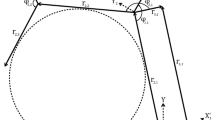Abstract
In industrial fields, precise pose of a 3D workpiece can guide operations like grasping and assembly tasks, thus precise estimation of pose of a 3D workpiece has received intensive attention over the last decades. When utilizing vision system as the source of pose estimation, it is difficult to get the pose of a 3D workpiece from the 2D image data provided by the vision system. Conventional methods face the complexity of model construction and time consumption on geometric matching. To overcome these difficulties, this paper proposes a search-based method to determine appropriate model and pose of a 3D workpiece that match the 2D image data. Concretely, we formulate the above problem as an optimization problem aiming at finding appropriate model parameters and pose parameters which minimizes the error between the notional 2D image (given by the model/pose parameters being optimized) and the real 2D image (provided by the vision system). Due to the coupling of model and pose parameters and discontinuity of the objective function, the above optimization problem cannot be tackled by conventional optimization techniques. Hence, we employ an evolutionary algorithm to cope with the optimization problem, where the evolutionary algorithm utilizes our problem-specific knowledge and adopts a hierarchical coarse-to-fine style to meet the requirement of online estimation. Experimental results demonstrate that our method is effective and efficient.
Similar content being viewed by others
References
Lowe, D.G.: Fitting parameterized three-dimensional models to images. IEEE Trans. Pattern Anal. Mach. Intell. 13(5), 441–450 (1991)
Dhome, M., Richetin, M., Laprest, J.T., Rives, G.: Determination of the attitude of 3D objects from a single perspective view. IEEE Trans. Pattern Anal. Mach. Intell. 11(12), 1265–1278 (1989)
Alter, T.D.: 3-D pose from 3 points using weak-perspective. IEEE Trans. Pattern Anal. Mach. Intell. 16(8), 802–808 (1994)
Huttenlocher, D.P., Ullman, S.: Recognizing solid objects by alignment with an image. Int. J. Comput. Vis. 5(2), 195–212 (1990)
Cass, T.A.: Robust affine structure matching for 3D object recognition. IEEE Trans. Pattern Anal. Mach. Intell. 20(11), 1265–1274 (1998)
Goldberg, D.E.: Genetic Algorithms in Search, Optimization, and Machine Learning. Addison-Wesley, Reading (1989)
Author, B.K., Burgess, J.C.: Neural networks and fuzzy systems. J. Acoust. Soc. Am. 103(6), 3131–3131 (1998)
Hill, A., Thornham, A., Taylor, C.J.: Model-based interpretation of 3D medical images. In: Proceedings 4th British Machine Vision Conference, pp. 339–348 (1993)
Fong, C.K., Yuen, S.Y.: A genetic algorithm with coverage for object localization. In: Proceedings of 2001 International Symposium on Intelligent Multimedia, Video and Speech Proceeding, pp. 48–51 (2001)
Shlens, J.: A Tutorial on Principal Component Analysis Derivation. Discussion and Singular Value Decomposition, Version 1 (2003)
Binford, T.O.: Visual perception by computer. In: Proceedings IEEE Conference on Systems and Control, pp. 231–240 (1987)
Kanade, T.: Recovery of the 3-D shape of an object from a single view. Artif. Intell. 17, 409–460 (1981)
Brooks, R.A.: Symbolics reasoning among 3D models and 2D images. Artif. Intell. 17, 285–348 (1981)
Ponce, J., Chelberg, D., Mann, W.B.: Invariant properties of straight homogeneous generalized cylinders and their contours. IEEE Trans. Pattern Anal. Mach. Intell. 11(9), 951–966 (1989)
Golub, G.H., Van, C.F.: Loan Matrix Computations. Johns Hopkins, Baltimore (1996)
Storn, R., Price, K.V.: Differential evolution—a simple and efficient heuristic for global optimization over continuous spaces. J. Glob. Optim. 11, 341–359 (1997)
Qin, A.K., Suganthan, P.N.: Self-adaptive differential evolution algorithm for numerical optimization. In: Proceedings of the 2005 IEEE Congress on Evolutionary Computation, vol. 2, pp. 1785–1791 (2005)
Yang, Z., Tang, K., Yao, X.: Self-adaptive differential evolution with neighborhood search. In: Proc. IEEE Congress on Evolutionary Computation, pp. 1110–1116 (2008)
Borgerfos, G.: Hierarchical chamfer matching: a parametric edge-matching algorithm. IEEE Trans. Pattern Anal. Mach. Intell. 10(6), 849–865 (1998)
Author information
Authors and Affiliations
Corresponding author
Rights and permissions
About this article
Cite this article
Liu, W., Chen, T., Wang, P. et al. Pose Estimation for 3D Workpiece Grasping in Industrial Environment Based on Evolutionary Algorithm. J Intell Robot Syst 68, 293–306 (2012). https://doi.org/10.1007/s10846-012-9686-5
Received:
Accepted:
Published:
Issue Date:
DOI: https://doi.org/10.1007/s10846-012-9686-5



